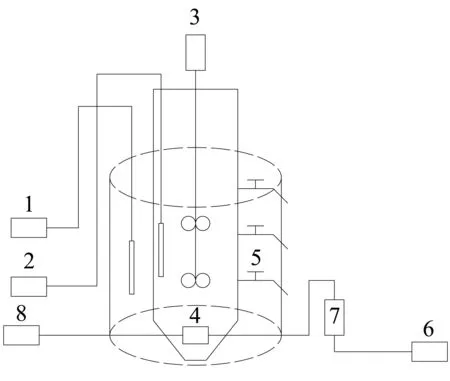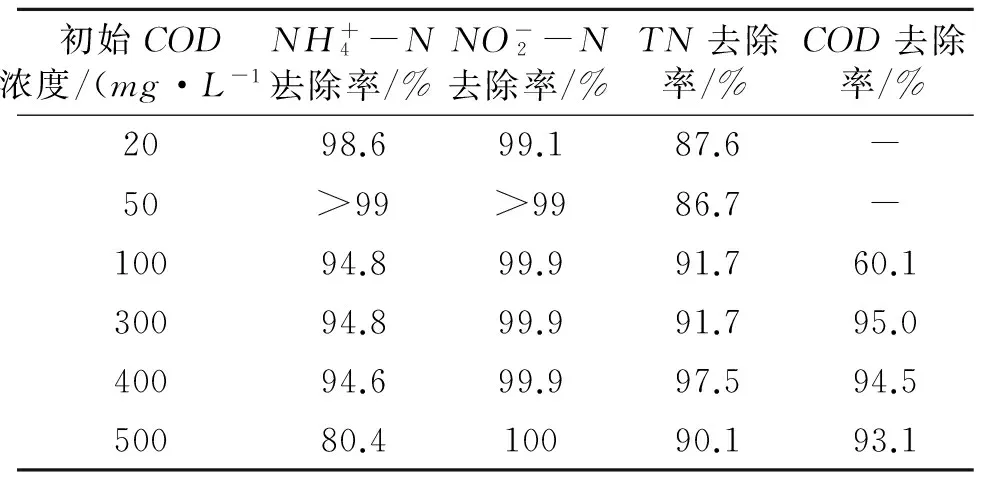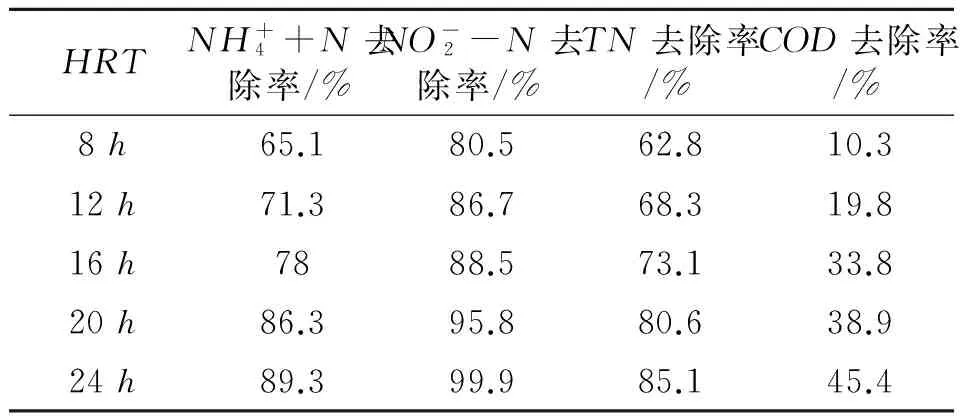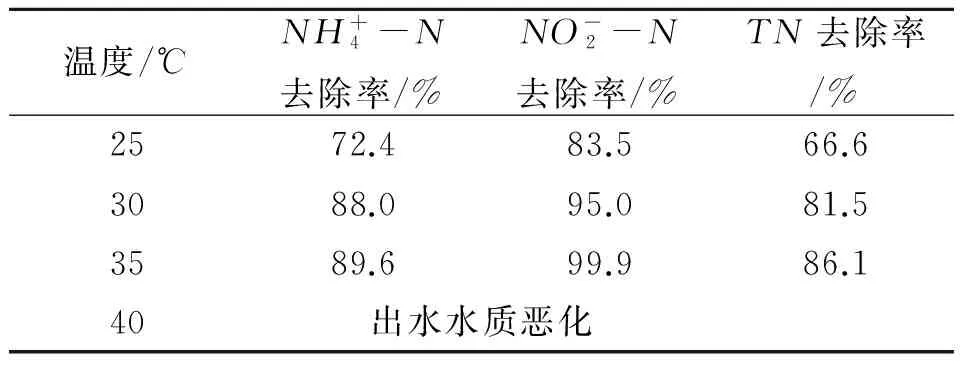序批式厌氧反应器厌氧氨氧化渗滤液脱氮试验研究
2016-07-18陈润竹解庆林刘琼李皓刘顺亮
陈润竹 解庆林 刘琼 李皓 刘顺亮
(桂林理工大学环境科学与工程学院 广西桂林 541004)
序批式厌氧反应器厌氧氨氧化渗滤液脱氮试验研究
陈润竹解庆林刘琼李皓刘顺亮
(桂林理工大学环境科学与工程学院广西桂林 541004)
摘要通过接种具有厌氧氨氧化性能的污泥,采用序批式厌氧反应器(ASBR)处理垃圾渗滤液,研究水力停留时间(HRT)、pH、温度等对厌氧氨氧化反应过程的影响并确定各因素的最佳控制范围。结果表明, 在本试验条件下,HRT、pH和温度的适宜范围分别为24 h、7.5~8.5和35 ℃。在此条件下,进水浓度为浓度为160 mg/L,COD浓度为300 mg/L时,出水平均浓度分别为15.5 mg/L、0.01 mg/L、43.2 mg/L和152.1 mg/L,相对应的平均去除率分别为89.7%、99.9%、86.1%和47.6%。
关键词序批式厌氧反应器厌氧氨氧化垃圾渗滤液
0引言
1材料与方法
1.1试验装置
序批式厌氧反应器(anaerobicsequencingbatchreactor,简称ASBR)装置如图1所示,由有机玻璃制成,总体积为8.0L,有效体积为6.5L,接种污泥为3.0L,在反应器壁上的垂直方向设置一排间距为40mm的取样口,用以取样和排水;底部设有排泥管;反应器外用黑布遮住避光。

1-pH仪;2-温控仪;3-搅拌器;4-曝气头;
5-气体流量计;6-曝气泵;7-出水口;8-进水泵
图1ASBR装置示意
1.2试验材料
本试验的污泥取自实验室已经驯化好具有厌氧氨氧化性能的污泥,接种前期驯化阶段采用了人工配水;本试验采用的渗滤液来自某生活垃圾填埋场。
1.3试验方法


试验条件是:HRT为24h,pH值控制在7.5~8.5,温度为35 ℃,反应器的出水率是有效容积的50%,即1.2L。

2试验结果与分析
2.1ASBR反应器人工配水厌氧氨氧化污泥的驯化培养


表1 不同COD浓度进水处理指标及去除率
2.2ASBR反应器垃圾渗滤液厌氧氨氧化驯化阶段
ASBR反应器渗滤液配水厌氧氨氧化驯化试验结果表明:

2.3厌氧氨氧化影响因素研究
2.3.1HRT对厌氧氨氧化脱氮效果的影响
在ASBR反应器内垃圾渗滤液厌氧氨氧化成功驯化的基础,保持进水pH为7.5~8.0,温度为35 ℃的条件下,逐渐增加HRT,每个HRT下稳定运行5d,研究不同HRT对厌氧氨氧化反应的影响。

表2 不同HRT去除率

2.3.2pH对厌氧氨氧化脱氮效果的影响
控制ASBR反应器HRT为24h,温度为35 ℃,研究pH对厌氧氨氧化反应的影响。

表3 不同pH条件下的去除率

2.3.3温度对厌氧氨氧化脱氮效果的影响
控制反应器HRT为24h,pH值为7.5~8.5,在不同梯度温度条件下稳定运行5d,研究温度对厌氧氨氧化反应的影响。

表4 不同温度条件下的去除率
3结论




参考文献
[1]VandeGraffAA.Anaerobicoxidationofamminiumisbiologicallymediatedprocess[J].AppliedandEnvironmentalMicrobiology, 1995,61(4):1246-1251.
[2]王晓霞,于德爽,李津,等.ASBR厌氧氨氧化反应器的快速启动及脱氮原理分析[J].环境工程学报,2012,6(6):1834-1840.
[3]ImajoU,TokutomiT,FurukawaK.Granulationofanammoxmicroorganismsinup-flowreactors[J].WaterSciTechnol,2004,49(56):155-163.
[4]解庆林,李小霞,李艳红,等.基于ASBR反应器的厌氧氨氧化启动及特性研究[J].环境科学学报,2009,29(4):759-762.
[5]StrousM,HeijnenJJ,KuenenJG,etal.Thesequencingbatchreactorasapowerfultoolforthestudyofslowlygrowinganaerobicammonium-oxidizingmicroorganisms[J].ApplMicrobiolBiotechnol,1998,50(27):589-596.
[6]DapenaA,ArrojoB,CamposJL.ImprovementofthesettlingpropertiesofAnammoxsludgeinanSBR[J].JChemTechnolBiotechnol,2004,79(12):1417-1420.
作者简介陈润竹,女,硕士,研究方向:水污染控制。
(收稿日期:2015-03-16)
NitrogenRemovalofLandfillLeachatebyAnaerobicAmmoniumOxiationinASBR
CHENRunzhuXIEQinglinLIUQiongLIHaoLIUShunliang
(College of Environmental Science and Engineering, Guilin University of TechnologyGuilin,Guangxi 541004)
AbstractAnaerobic ammonium oxidized sludge is inoculated into the equipment of sequencing batch reactor (ASBR) to dispose of the landfill leachate, to study the effect of HRT, pH and temperature to the anaerobic ammonium oxidation process and to determine the optimal controlling range. Results shows that, the optimal HRT, pH and temperature of the experiments are 24 h, 7.5~8.5 and 35 ℃. Under such circumstance, the influent concentration of -N, -N and COD are 150 mg/L, 160 mg/L and 300 mg/L, and the average effluent concentration of -N, -N, TN and COD are 15.5 mg/L、0.01 mg/L、43.2 mg/L and 152.1 mg/L, with the average removal rate are 89.7%, 99.9%, 86.1% and 47.6% respectively.
Key Wordsanaerobic sequencing batch reactor(ASBR)anaerobic ammonium oxidationlandfill leachate
